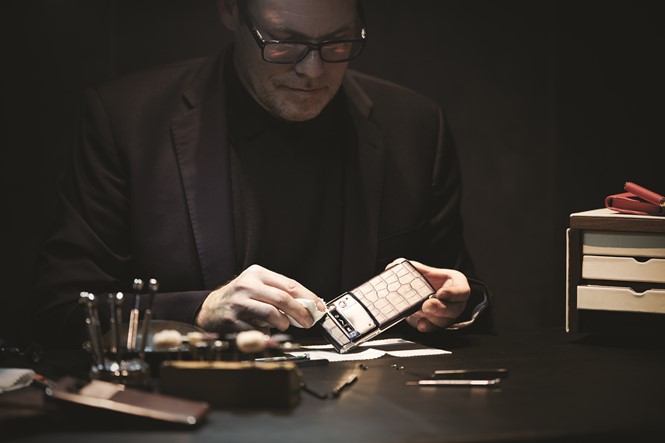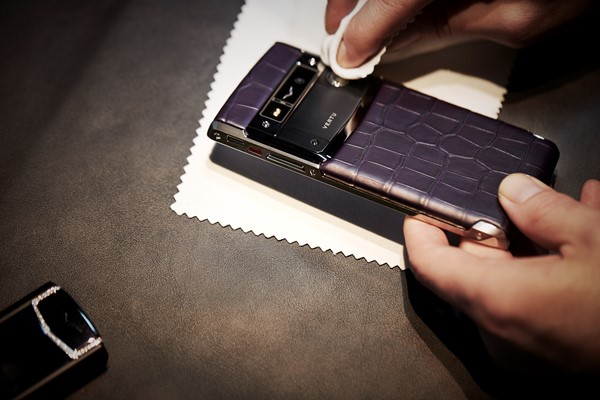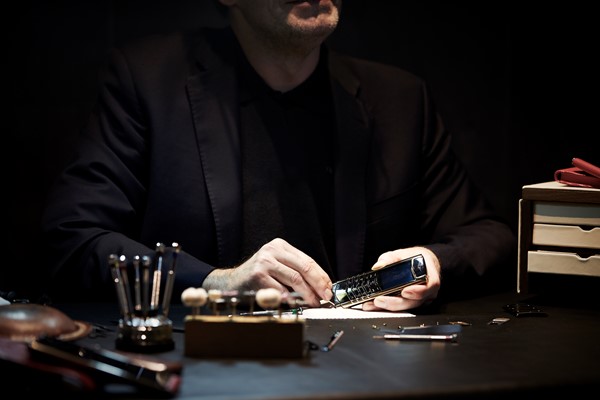Brand profile: Vertu

As a manufacturer, building a brand around the individual is a risky proposition. Jeremy Owen evaluates the mass appeal of the most exclusive luxury items through the lens of high-profile smartphone purveyor, Vertu
Massimiliano Pogliani, CEO of luxury mobile phone manufacturer, Vertu, once said of its customers, they "Never just go for the ordinary in anything they do." Like any good leader he considers his company to be extraordinary, but it is not just its products that break the mould. Vertu's approach may force a rethinking about how companies approach the practice of brand building.
It is commonly accepted that it is the means of production that has given rise to the modern practice of branding. The mass-manufacture model has resulted in fabrication of products that all look the same and generally perform the same function, but commerce needs differentiation and branding is a way of making individual products stand out from one another. Vertu has based its brand proposition on the concept of customisation, luxury and bespoke craftsmanship. Its phones feature the highest quality products and are built by dedicated craftsmen, generating a demand among those able to commission such a device.
What doesn't stnad out, however, is Vertu's Hampshire-based headquarters. The building's unassuming facade implies that the daily practice of the company within is fairly unremarkable. A fairly non-descript, modern two-storey building on the edge of leafy woodland and new build housing, the only clues to the nature of the business might be the high perimeter fence, heavy security gates or the security guard efficiently shepherding visitors. Overt identification is sparse, a lone logo, in itself a low-key lock-up of slim-line font and a chevron in 3D letters with perhaps a hint of backlighting. Although subtle, this should not be read as the noncommittal approach of a business happy to tick over. Rather, it should be seen as a microcsmic example of Vertu’s overall approach to business. The default setting for modern branding is to shout as loud as possible to everyone who might possibly hear. Vertu by contrast, prefers to whisper confidently in the ears of those who it deems to be worthwhile.
Basic visual research will quickly reveal that the methods by which Vertu communicates are low-key. Traditionally its marketing and advertising material has consisted of product and pack-shot led imagery, a tried and tested approach, but one that works. Recent product launches have seen a move into narrative based imagery, an approach currently common to many luxury brands and more recently, emotive lifestyle- based storytelling. When a company follows trends there is a risk that communications become invisible against brands that are more established in the public sphere but share similar motifs; Vertu’s earlier dreamlike imagery calls to mind Louis Vuitton or Cartier for example. They show a company adhering to current trends so as to maintain a certain visibility in accepted channels such as press advertising. This forms a functional base layer of communication but when it comes to mainstream media, as demonstrated by its HQ, Vertu prefers something more subtle. Where Vertu appears more is via a PR-led approach that broadcasts the message via channels that inspire interest in the products for their own merit; in practice this translates to less overly ostentatious viral videos on YouTube and more real press wordage discussing features, components and finishes.
In the luxury market, products have their own identities. But even with signature manufacturing traits of specific brands – the Bottega Veneta twist, the distinctive silver of Tiffany & Co., the cut of a certain Savile Row suit – the overall effect can still be somewhat homogenous. By contrast, Vertu avoids becoming generic as a rule. It exists within the luxury market, but as a smartphone manufacturer it naturally has to stand out. Similarly, it is part of both the technology and mobile phone markets, but again stands out with a price tag that starts at £4,000 and goes to as much as the consumer has to spend. Pogliani said in a 2013 interview with GQ, “When you are CEO of a tech company, the next two years are planned out – it’s all about thinking what’s going to be popular in three years time. My role is to keep my eyes open on what’s going to be the next evolution in communication and also services.”

It is important to note exactly what it is that Vertu is selling. Since starting in 1998 as an experimental offshoot of Nokia UK, its first finished product, which arrived in 2002, has over the years been joined by other models. Today, the original push-button Signature can be purchased alongside the smartphones Signature Touch and Aster, both of which run on the Android platform. Each has the backroom functionality that you would expect from a modern phone plus the usual accoutrements of camera, speakers, high resolution screens, etc.
But what sets Vertu apart from other phone brands is a level of craftsmanship more often found in the finest watchmaker or high performance car. Its components are sourced from the best suppliers. Some handsets boast leather from a small Austrian tannery or real hardwoods; all have sapphire crystal screens that are grown to order and ringtones that eschew synthesised sounds for bespoke recordings (by the London Symphony Orchestra). Each unit is then hand-built by an in-house artisan who finishes it with their signature engraved inside the phone, a detail that has created its own hierarchy of desirability among customers who now request handsets by specific craftsmen. And it doesn’t stop there. Vertu’s trademark attention to detail extends to a customer service portfolio that provides unprecedented access to the finest life experiences money can buy; sports fixtures, arts events, fine dining; a personal concierge to fulfil your every request, unrivalled connectivity and the highest level of security.
Post-2008 it’s easy to disparage such excess. Even CEO Pogliani said, “No one needs one of these phones.” Indeed, once the basics of shelter and sustenance are provided, fine jewellery, fast cars or expensive meals are just luxury. The people who buy Vertu keep coming back, though; Vertu’s customer base includes a substantial percentage of return buyers. As both the luxury and technology markets are competitive, fast moving and fickle, companies can invest energy and money into an idea they hope is original only to find a competitor suddenly announces something that renders their work obsolete when customers shift allegiance.
“OUR MISSION IS TO BE LEADING EDGE NOT BLEEDING EDGE”
Vertu’s savvy is to make its size into a virtue, a boon that customers seem to value. It maintains its position as the most relevant brand in the luxury smartphones marketplace by knowing what it is selling and two whom it is selling and firmly adheres to that. PR director Jon Stanley summarises this approach concisely, “Our mission is to be leading edge not bleeding edge.” Customers are business people, film directors, sports stars; essentially people with a lot of money and a desire to support their self-image by high-quality life accoutrements. This is a group in which different types of people are united by a passion for a certain product. They are an audience that instinctively understands the message of the product and its related communications material, no matter how slim that material is in comparison to other brands and, importantly, they are happy to receive these messages, and act upon them, over and over again.
With luxury brands, although they probably won’t like to admit it, those that make the products are most probably never the end users save for when they receive product at staff price or if a product is part of a salary agreement. The same is true of Vertu but with a major difference. Their employees may not be the people actively consuming the brand in the commercial sense but they are the ones that truly define the brand emotionally speaking. There are over 30 nationalities represented in the Vertu HQ and within that a smorgasbord of different talents and job descriptions, but they have all been hired due to their dedication to the company vision; to create a product that is reliable, of high quality and exudes expertise at every level. With Vertu, the effect is something like a fine wine. It takes time to put these products together but the result is a product with a real point of difference. It is the mode of manufacture of this difference that has determined the business model, which in turn has defined the brand.
In current discussions of branding there is much hand wringing over effective ‘internal brand creation.’ Inherent in this is a suggestion that an internal brand is somehow different to an external brand, perhaps even an afterthought. Vertu shows that the formula for effective branding has been there all along. It is not about size or scale of business, it is not about striving to keep ahead of trends, it is about maintaining an internal culture where first and foremost staff live the brand. It is in the individual’s personal dedication to apply their personal skills where a brand truly exists.



